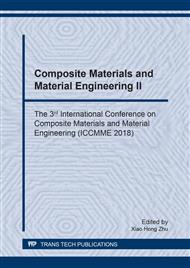[1]
Al Hazza M H F, Adesta E Y, Seder A M. Using Soft Computing Methods as an Effective Tool in Predicting Surface Roughness,, in Advanced Computer Science Applications and Technologies (ACSAT), 2015 4th International Conference on, 2015, pp.9-13.
DOI: 10.1109/acsat.2015.17
Google Scholar
[2]
Liman M M, Abou-El-Hossein K, Jumare A I, Odedeyi P B, Lukman A N. Modelling of Surface Roughness in Ultra-High Precision Turning of an RGP Contact Lens Polymer,, in Key Engineering Materials, 2017, pp.183-187.
DOI: 10.4028/www.scientific.net/kem.753.183
Google Scholar
[3]
Krolczyk G, Legutko S, Gajek M. Predicting the surface roughness in the dry machining of duplex stainless steel (DSS),, Metalurgija, vol. 52, pp.259-262, (2013).
Google Scholar
[4]
Altunpak Y. Optimization of cutting parameters and graphite rate in drilling of a hybrid aluminium matrix composites,, Journal of Engineering and Fundamentals, vol. 2, pp.42-50, (2015).
DOI: 10.17530/jef.15.17.2.2
Google Scholar
[5]
Adesta E Y T, Al Hazza M H, Suprianto M, Riza M. Predicting surface roughness with respect to process parameters using regression analysis models in end milling,, in Advanced Materials Research, 2012, pp.99-102.
DOI: 10.4028/www.scientific.net/amr.576.99
Google Scholar
[6]
Öktem H, Erzurumlu T, Kurtaran H. Application of response surface methodology in the optimization of cutting conditions for surface roughness,, Journal of materials processing technology, vol. 170, pp.11-16, (2005).
DOI: 10.1016/j.jmatprotec.2005.04.096
Google Scholar
[7]
Cakir M C, Ensarioglu C, Demirayak I. Mathematical modeling of surface roughness for evaluating the effects of cutting parameters and coating material,, Journal of materials processing technology, vol. 209, pp.102-109, (2009).
DOI: 10.1016/j.jmatprotec.2008.01.050
Google Scholar
[8]
Al Hazza M H, Adesta E Y T, Riza M, Suprianto M. Surface roughness optimization in end milling using the multi objective genetic algorithm approach,, in Advanced Materials Research, 2012, pp.103-106.
DOI: 10.4028/www.scientific.net/amr.576.103
Google Scholar
[9]
Al Hazza M H F, Adesta E Y, Superianto M, Riza M. Cutting Temperature and Surface Roughness Optimization in CNC End Milling Using Multi Objective Genetic Algorithm,, in Advanced Computer Science Applications and Technologies (ACSAT), 2012 International Conference on, 2012, pp.275-278.
DOI: 10.1109/acsat.2012.39
Google Scholar
[10]
Senthilkumar N, Tamizharasan T, Anandakrishnan V. An ANN approach for predicting the cutting inserts performances of different geometries in hard turning,, Advances in Production Engineering & Management, vol. 8, p.231, (2013).
DOI: 10.14743/apem2013.4.170
Google Scholar
[11]
Özel T, Karpat Y. Predictive modeling of surface roughness and tool wear in hard turning using regression and neural networks,, International Journal of Machine Tools and Manufacture, vol. 45, pp.467-479, (2005).
DOI: 10.1016/j.ijmachtools.2004.09.007
Google Scholar
[12]
Lakshminarayanan A, Balasubramanian V. Comparison of RSM with ANN in predicting tensile strength of friction stir welded AA7039 aluminium alloy joints,, Transactions of Nonferrous Metals Society of China, vol. 19, pp.9-18, (2009).
DOI: 10.1016/s1003-6326(08)60221-6
Google Scholar
[13]
Liu X, Gu H. Hyperbolic tangent function based two layers structure neural network,, in Electronics and Optoelectronics (ICEOE), 2011 International Conference on, 2011, pp. V4-376-V4-379.
DOI: 10.1109/iceoe.2011.6013509
Google Scholar
[14]
Asiltürk I, Çunkaş M. Modeling and prediction of surface roughness in turning operations using artificial neural network and multiple regression method,, Expert Systems with Applications, vol. 38, pp.5826-5832, (2011).
DOI: 10.1016/j.eswa.2010.11.041
Google Scholar


